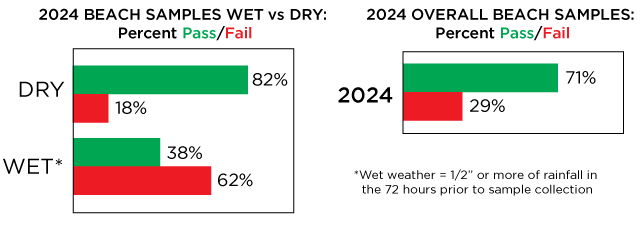2024 Bacteria Monitoring Stats
64 sites, 739 water samples,
27 trained volunteers
2024 Bacteria Sampling Data
Weekly Monitoring Data Maps
Westchester, NY & Greenwich, CT pdf xls
Queens & Nassau Counties pdf xls
Summary by Site pdf xls
Quality Assurance Project Plan pdf
Map Legend
Quick Links
Select Year: 2024 • 2023 • 2022 • 2021 • 2020 • 2019 • 2018 • 2017 • 2016 • 2015 • 2014
Fecal Bacteria Monitoring
In 2024, Save the Sound collected and tested water quality from Greenwich, CT, through Westchester County, to Queens, NY and into Nassau County. Samples were analyzed for fecal indicator bacteria, Enterococcus in marine water and E. coli in freshwater, which are used to determine if waters are safe for swimming. Click on each site on the map above to see what we found. The colors reflect average bacteria levels at each site. The “% Pass” and “% Fail” show how many samples passed or failed the single sample criteria for safe swimming in New York and Connecticut.
State Criteria for Safe Swimming
Samples greater than 104 CFU/100 mL Enterococcus are considered unsafe for swimming in marine water. Samples greater than 235 CFU/100 mL E. coli are considered unsafe for swimming in fresh water.
A weighted average (geometric mean) greater than 35 CFU/100 mL Enterococcus is considered unsafe for swimming in marine water and greater than 126 CFU/100 mL E. coli is considered unsafe for swimming in fresh water.
Summary of Findings: 2024 Season
Overall Failure Rates Increase
Overall fecal contamination rates decreased from 2023 to 2024 from 64% to 60%. Dry weather fails were similar to 2023 but there were over 100 more dry weather samples overall. The wet weather failure rate decreased by 1%. It is important to note there was less rain around sample dates demonstrated by the 195 wet weather samples collected in 2024 compared to 395 in 2023.
 Failure is based on safe swimming criteria used in New York and Connecticut to monitor and manage beaches. Because wet weather causes pollution to flush off the landscape and into the waterways, and can trigger overflows of untreated sewage, Save the Sound reports on wet weather samples separately. This year, as in all past years, fecal contamination was higher after rainfall at most locations.
Failure is based on safe swimming criteria used in New York and Connecticut to monitor and manage beaches. Because wet weather causes pollution to flush off the landscape and into the waterways, and can trigger overflows of untreated sewage, Save the Sound reports on wet weather samples separately. This year, as in all past years, fecal contamination was higher after rainfall at most locations.
River Sites Remain Problematic
Rivers remained the most polluted sites in 2024. There was a collective decrease of 2% in failure rate in rivers compared to 2023. Regardless, 77% of samples collected in rivers in 2024 failed. Many of these rivers running through our communities are carrying an unacceptable level of fecal contamination which poses a risk to human health.

Hit the Beach (During Dry Weather!)
There are 7 swimming beaches sampled along the coastline from Greenwich, through Westchester, and in Queens. Collectively, beach site sample results are encouraging, especially during dry weather. These tend to be the types of days people actively would like to get in and around the water at their local beach during the summer heat! Of the 62 dry weather samples collected at beaches in 2024, 82% passed state safe swimming criteria. Conversely, only 62% of samples collected during wet weather passed the same criteria. Many beaches have preemptive closures based on previous data collected by local health department and precipitation totals. The lower pass rate is largely tied to impervious coverage such as roads, parking lots, and roofs directly surrounding a beach and its local watershed. Aging and failing sanitary sewer infrastructure can also play a large role in beach sample results. It is also important to consider the presence of local wildlife, such as resident Canada geese, which can deposit large amounts of waste high in fecal indicator bacteria into the waters at swimming beaches.

Best and Worst of 2024
There weren’t any locations this year that did not have any failing samples but numerous locations had only 1. There were 14 locations that failed every time they were sampled.


Be a Part of the Solution
As long as rivers, streams, and our coastline are polluted, Save the Sound remains committed to restoring water quality where people swim, fish, and paddle.
- Everyone can help reduce sewage pollution simply by conserving water, which will lessen the wear and tear on our water infrastructure and reduce sewage overflows by lowering the volume of water in the system.
- Homeowners and business owners must repair the sewer lines that connect their properties to municipal sewers or maintain their septic systems.
- Dog owners should dispose of pet waste in the trash, never in a catch basin or on the street.
- Save the Sound encourages all members of the public to be on the lookout for water pollution. If you see sewage overflowing in your community, please report anything you see to your local health authorities and to Save the Sound. Let us know by sending a photograph or video plus the time and location of the overflow to pollution@savethesound.org.
